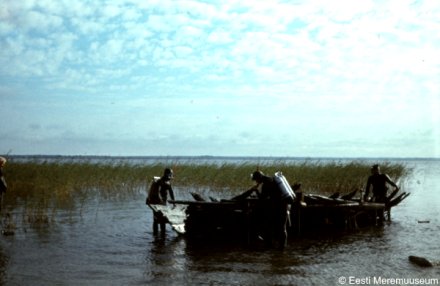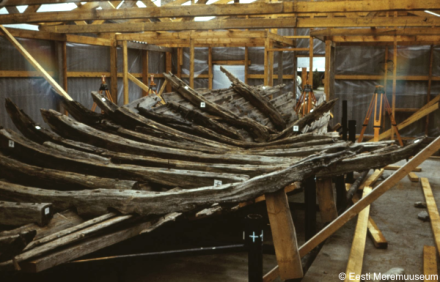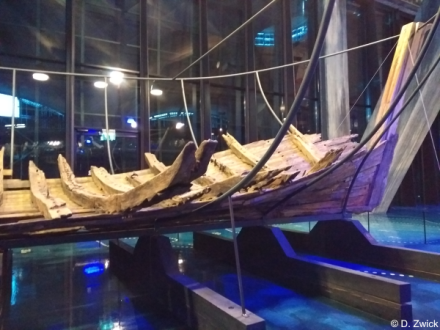History
This shipwreck was discovered in the Väike-Väin Sound, dividing the western Estonian islands of Saaremaa and Muhu. It was situated 370 metres off the coast of the island of Saaremaa at a depth of 3 metres, in a natural harbour at the foot of the Maasilinn castle ruin.



The wreck was excavated and lifted in 1987 by Viikar divers, a group of recreational divers interested in archaeology under the lead of Vello Mäss, who became the head of the newly formed division of underwater archaeology at the Estonian Maritime Museum in the following year. The wreck was conserved in a purpose-built facility with PEG (polyethylene glycol) and smaller object were freeze-dried. Owing to the novelty of a fully fledged archaeological wreck excavation and the lack of experience, the wreck was only partially recorded and sampled.
Samples from the clinker planks were dendrochronologically analysed and yielded felling dates in the 1543-1546 range. Almost the entire hull was built of local pine.
The vessel was associated with a small single-masted coastal vessel known as uisk.
The wreck's location and residues of slaked lime in its bilge suggest that it was linked to the castle of Maasilinn (German: Soneburg) and its lime quarry, which was owned by the Order of Teutonic Knights at that time. This period was marked by intensified castle building across the territories of the Livonian Confederation and the vessel was arguably involved in the shipping of lime required as building material.

Description
The Maasilinn Ship is the hitherto earliest known type of wreck, in which a secondary layer of carvel planks were fastened on top of an originally clinker-built hull (a so-called “converted clinker”). The exact building sequence is still subject to hypothesis. Another notable feature is the deep bilge-well, achieved by garboard strakes running almost vertically.


| Length | 52 ½ feet (16 m) |
|---|
Status
The wreck is on display in the Estonian Maritime Museum's Seaplane Harbour in Tallinn since 2010. As earliest archaeological wreck salvage in Estonia, it forms a central part of the museum's collections.




References
- Estonian Maritime Museum.
- Aluve, K. & Pärt, I. (1986).
Aruanne Maasilinna laevavraki nr. 1 puidu dendrokronoloogilisest määrangust (unpublished report).
Eesti Meremuuseum (Estonian Maritime Museum). - Arens, I. (1986).
Nytt Vrakfynd i Estland. Om ett fartygsfynd från 1500-tallet vid Ordensfästningen Soneburg (estn. Maasilinn) på Ösel sommaren 1985.
Bottnisk Kontakt 3.
pp 46-50. - Ilves, K. (2002).
Merenduslik kultuurmaastik ja Maasi laev kui selle element.
Eesti Arheoloogia Ajakiri 6.2.
pp 134-149. - Ilves, K. (2008).
Maritime Archaeology: the Case in Estonia.
In: A. Pydyn & J. Flatman (eds.), Collaboration, Communication and Involvement: Maritime Archaeology and Education in the 21st Century.
pp 157-170. - Mäss, V. (1991).
Prospects for Underwater Archaeology in the Eastern Baltic.
The International Journal of Nautical Archaeology 20.4.
pp 313-320. - Mäss, V. (1994).
A Unique 16th Century Estonian Ship Find.
C. Westerdahl (ed.), Crossroads in Ancient Shipbuilding (= Proceedings of the Sixth International Symposium on Boat and Ship Archaeology, Roskilde 1991).
pp 189-194. - Mäss, V. (1994).
Underwater Archaeology in Estonia.
Proceedings of the Estonian Academy of Sciences 43.
pp 97-100. - Zwick, D. (2017).
Maritime Logistics in the Age of the Northern Crusades (= doctoral dissertation).
University of Kiel.